
Atlas F1 Technical Writer
A few teams presented new revisions to their 2002 cars at Silverstone, most notably the new Jaguar R3B chassis. Craig Scarborough reviews the cars and their performance
It was clear that the Bridgestone tyres were working better in the wet than the Michelins. And while the advantage was more than clear during the race, the whole weekend transpired to work against the Michelin runners.
The interrupted practice session prevented the teams from scrubbing new tyres in for the race, and most of the cars started on fresh un-run tyres. In theory, lightly scrubbed tyres should give more initial grip in the wet as the release agent coating the tyres makes them slippery. But in the colder conditions the slightly damp track was much colder than the tyres are used to work on, so getting the tyres up to temperature and keeping them there was a problem for many drivers.
When the rain started to fall some 15 minutes into the race, the choice of intermediates was still a tricky one, since the rain was very light and varied across the track. Furthermore, the strong wind was bringing in lighter clouds, so there was a good chance that the shower would pass. This clearly influenced McLaren's thinking.
The rain, however, did not subside until much later in the race, and crucially for McLaren a slick tyre does not work well in lightly damp conditions, whereas an intermediate works well in the damp but also relatively well on a drier track. Moreover, the intermediate's softer compound keeps the tyre up to temperature, while a 'slick' tyre's harder compound runs too cool to be effective in these conditions.
The main problem with intermediates is that they over-heat on a drying track, forcing the drivers to go off line to cool the tyre on the wet part of the track. Intermediates suffer when the they have been run on a dry track and the weather turns wet again - the edges of the grooves get worn from the dry track and provide no rain clearing edge to bite into the wet track.
Between the makes, Bridgestone cars had a clear advantage on intermediates, while many of the Michelin shod cars were struggling to brake and turn in for the slower sections of the track. McLaren, who opted not to test as much at Silverstone this year, were dreadful in this respect.
Developments
As the teams near the end of the intensive development work on their 2002 cars, the race marked the arrival of several major aero updates. And, with these now passed from the design departments to the teams, the design department can now dedicate more resources to the design of the 2003 car.
With over five months until the new year's testing sessions, the new car will be largely decided: the aerodynamic concept will have been agreed and major components - such as the engine, gearbox and monocoque - will have had the basic design drawn up. What is left is the detail design of these parts and the myriad of associated parts.
Furthermore, these major components have a long production lead time - the monocoque and gearbox casing in particular will be signed off for production long before the end of the season in order to be ready before the first chassis is built up, some time in December.
Team by Team
Ferrari
The weekend didn't start well, when Michael Schumacher lost the Friday morning session after harmlessly spinning and stalling the car - Ross Brawn noted the problem was caused by a software error which stopped the engine. There were also small problems for Schumacher throughout the Saturday sessions, leading him to use the spare car on several occasions.
Ferrari were able to find their pace quickly in all the weather conditions that Silverstone could provide, and this was in spite of only one testing appearance at the circuit. Schumacher went for an early run in qualifying to ensure he had time to make any changes he felt necessary for later in the session, while Rubens Barrichello enjoyed a smoother few days and finally matched his teammate for pace towards the end of the Qualifying session.
For Barrichello the problems started as the field left the grid for the formation lap - he tried to engage first gear to leave the grid and the car stalled. The team were able to get the car started, but the field had already left and he had to start from the back of the grid.
Both Ferraris were full of fuel in anticipation of the rain, which in turn meant Schumacher was unable to outrun Juan Pablo Montoya into the lead, at the start of the race. In the meantime, however, Barrichello's comeback drive from the back demonstrated the huge advantage the F2002 has in both corner entry and exit speed - he could pass one car under braking into a corner and line up the next car going up the following straight.
But Ferrari's man of the race must have been Englishman Ross Brawn, who was left to make the tyre decisions for his drivers. Brawn called them as well as any other team on the grid, queuing the cars up in the pit for new tyres. Bridgestone were multiplying Ferrari's car advantage in the wet conditions, and both Schumacher and Barrichello were able to lead clear of Montoya by a full pitstop.
Williams
Some new aerodynamic parts were expected for Silverstone, but the scale of the changes were underplayed by the team beforehand.
The trailing edge of the sidepod top is now longer and covers the rear suspension. The engine cover is also much narrower, and several blisters have been moulded into the rear end to clear the suspension. The resulting rear end is now very Ferrari-like and is aimed at improving grip at the rear to enhance rear tyre wear. An additional mid-wing mounted behind the roll over structure was added, but may not be a permanent part of the new rear end.
Friday was given away to wet tyre testing, and some data was gathered from the new bodywork. Montoya had an engine failure on early Friday, but otherwise the team were happy with the car's performance in the wet.
In qualifying, the team were trailing Ferrari by a small margin and changes made to the car throughout the dry session were bringing improvements. The last of the improvements and some inspired driving brought Montoya his fourth successive pole position, while Ralf Schumacher ended in a competitive fourth place.
A curious strategy in the warm up lead the team to share the T-Car between both drivers and not use their race cars. This may have been to limit mileage on the race engine, but did limit their understanding of the race car's set-up for the colder conditions.
Of all the cars, the Williams brakes glowed the brightest in the warm up and race. Williams are known to use different disc manufacturers to most teams, but the difference to all the others was striking.
During the race, Montoya managed just barely to keep the Ferraris at bay in the dry, but was completely outclassed in the wet due to his Michelin inferiority. Ralf Schumacher, in the meanwhile, had a succession of problems in the pits - bad tyre choices and fuel rig problems relegated him to an 'also ran', in a race where he could have finished fourth.
McLaren
There was nothing new on the cars for Silverstone, but the team did unveil their new pit crew cooling suits and new helmets. The new outfits - jointly developed by Hugo Boss and Med-Eng Systems - consist of an awkward looking back-pack that provides cooled liquid through tubes set into the fireproof overalls. McLaren are aiming to improve the comfort of the crew while they are sat around the pit during hot races, in the hope that they are constantly dressed for unexpected pitstops and can work to the maximum ability in hotter climates.
Kimi Raikkonen suffered an engine failure in qualifying and had to resort to the T-Car. David Coulthard also suffered an engine failure in the warm up and used the T-Car - which was set up and sign-written for Raikkonen - towards the end of the warm up. Come the race, all a McLaren spokesperson would say was that it was a "different" engine installed Coulthard's car.
The pitstop dramas that affected the team will no doubt go down into F1 folklore, as the poor timing and tyre choice were exacerbated by interference on the pit-to-car radio. However, it must be said that regardless of the timing, the cars struggled dreadfully on the Michelin wet tyres; time after time Coulthard and Raikkonen would understeer off on the slower corners and run across the grass to rejoin the track.
Raikkonen's race was eventually ended by another engine failure, while Coulthard's pace improved as the track dried, and he eventually ended up 10th, displaying damage to the left side of his sidepods.
Renault
Renault were another team to debut new rear end aerodynamics, with a major revision to its sidepods. The set up appears similar to McLaren's, with a long low flip up beneath a hot air outlet. But whereas McLaren have a small winglet above these two, Renault used a third flip up which, when viewed from above, curves in toward the rear, matching the coke bottle shape.
This set up had not been run on track previous to this race and only the racecars were set up to use it. Designer Mike Gascoyne shrugged off this major development for the team as "part of the normal race by race aerodynamic programme."
The new sidepods were matched to a new lower rear wing/mount proving the changes were to improve the airflow to the rear wing, in order to provide extra grip at the rear. As with all teams bringing new aero parts to this race, there was little to be learnt from the package in the wet sessions and the old bodywork was reinstated for the race.
In the race, the car was up with the McLarens until the rain fell. The team then made the right choice for the first tyre stop, queuing the cars up for intermediates. The cars went better in the wetter conditions than most Michelin runners, but unreliability started to creep in for the team. Trulli had electronic problems affecting traction control and gear changes and decided to retire the car. Button had a more unusual problem: "I noticed that the front left wheel was starting to move about," he said, and he pulled the car into the pits to retire.
Sauber
Sauber did not run the new floor and diffuser seen in testing, but did enjoy good reliability for the whole weekend. As with most teams, they struggled with understeer and traction on the wet and slippery track.
In the race, Felipe Massa spun on the grass while still running along the start straight. Nick Heidfeld felt his tyres were under temperature and suffered resulting understeer and poor traction in and out of corners. Both drivers came in early for intermediate Bridgestone tyres to make up the places lost from their earlier problems and then maintained a competitive pace for the rest of the race.
Jordan
There have been no major changes to the Jordan car since the new wings were introduced. The flat wing was run on Friday as part of the team's evaluation of the wet conditions - the more normal curved wing was chosen for the balance of the weekend.
Two sets of engine failures, including one in qualifying, blighted Giancarlo Fisichella's Saturday and forced him into the T-Car to qualify. Takuma Sato suffered a rare and potentially dangerous failure when his nose cone partly dismounted itself from the chassis. Yet still both drivers were happy with the car in the conditions on the Bridgestone tyres.
In the race, the cars worked well on the Bridgestones and both drivers kept pace with the midfield. Sato suffered yet another Honda engine failure, leaving him without any points so far this year. Fisichella on the other hand picked up seventh in the race, only just out of the points behind Nick Heidfeld in Sixth.
BAR
BAR initially struggled on the wet circuit, but Jacques Villeneuve found the car to work better in the wet, while Olivier Panis puzzled over the car's new-found tendency to oversteer and struggle with traction.
Come qualifying, Villeneuve pushed the car to an excellent ninth despite gearshift problems with the still quite new gearbox. Panis endured more problems during the morning session, and with the loss of track time he was slower than his teammate and down to 13th on the grid.
Panis's string of problems continued into the warm up, when he stopped in the pitlane exit, having stalled during a practice start and had to push the car back to the garage. He had suffered similar problems all weekend and ended up using the T-Car.
A curious feature of the BARs in the warm up and race was that the rear brakes glowed more brightly than the fronts. Whether this was due to rearward brake balance or different discs being fitted to the rear isn't clear.
In the race, the team's local knowledge was bolstered by factory staff and team boss David Richards's helicopter pilot acting as weathermen. This insight into the rain provided the team with the right choices for their pitstops. Both drivers found the car working well in the wet, and for the first time this year the BARs were on the pace and passing other cars. BAR and Honda reliability lasted and the team brought their first batch of points this year.
Jaguar
Friday went otherwise well for the team and no technical problems were reported. Saturday, however, brought lots of problems for Pedro de la Rosa - engine problems forced him out of his racecar and into Eddie Irvine's spare, and for a while the Spaniard looked like he might not qualify within the 107% rule. He eventually took to the track and posted the 21st best time, beating only Alex Yoong and leaving him last on the grid when Yoong failed to qualify.
Irvine had less technical problems but struggled with the new set-up in the fickle conditions, and while he declared the new car had "more downforce and the handling has also improved," 19th was not where he expected to be after qualifying.
In the race, the team opted for the full wet Michelin tyres, and after the initial rain this proved to be an error. Moreover, after an encouraging run in the drier early laps, Irvine spun out of Stowe corner and after slithering across the grass he eventually ripped his front wing off against the barrier. At the same time, de la Rosa usefully completed a full race distance for the team but well down the field.
Arrows
There were no new parts on the Arrows cars at Silverstone, but for the whole of Friday there was one crucial part missing from all of their cars - the Cosworth engines' ECU.
Due to the ongoing financial argument with the team and their suppliers, Cosworth allowed Arrows to fit the engine and most of the ancillaries, but held the team to ransom by the removal of the black box mounted inside the sidepods. This simple measure prevented the team from running the cars throughout Friday, while the legalities and finances were sorted out.
Nevertheless, with every run the drivers expressed more confidence in the car's handling and felt positive towards the race. In the race, Arrows made the right strategy calls and benefited from the better Bridgestone wet weather tyres. The cars were amongst the quickest on the track in the wet, but both cars drew to a halt, with a driveshaft failure for Enrique Bernoldi and ironically an engine failure for Heinz Harald Frentzen.
Toyota
With the car's specification unchanged for this race, Toyota were not sure what to expect from the circuit. The wet weather did not help their cause and neither did Mika Salo sitting out Friday on doctor's orders with a stomach infection.
Allan McNish started to evolve a set up for the conditions and changed the car's behaviour from understeer to his preferred oversteer. On Saturday morning, McNish was unfortunate to hit a hare running across the straight, damaging his front wing. By now the car was better balanced, but traction was still poor in the slower third sector. Nevertheless, qualifying went well and resulted in the team's best grid slot to date for the recovered Mika Salo, in eighth.
At the start of the race, McNish suffered another clutch problem and stalled as the grid got away. Salo at the same time found his set up to be too light on downforce and eventually retired with a drive train problem, completing another disappointing weekend for the team.
Minardi
There was a new front wing endplate on the Minardi cars this weekend - the new version curved in more between the front wheels - which was tried for qualifying but not for the race.
The first two practice days went without major technical hitches. The cars worked better when the conditions were wetter and both cars were compromised with no power steering this weekend. Alex Yoong suffered more from the lack of the power assistance, and added to his inexperience and some handling problems, he failed to make the 107% time for the grid and was not allowed to start the race. Mark Webber had less issues with the car, but still only managed 20th in qualifying.
In the race, Webber was able to pass several cars in the dry until the tenth lap when the rear of the car snapped sideways under braking - having run into clutch problems - and left him stuck in the gravel, ruining what may have been a competitive race.
Silverstone demands a balance of downforce between its fast corners and slower sections, which makes it very much an aerodynamic track. Tyres played a smaller part in the opening two days of the weekend, but come the race day, tyre choice and timing pretty much decided the result.
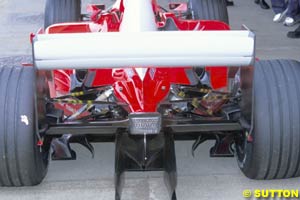 Featuring the revised engine cover and the distinctive curved Gurney flaps on the rear wing, Ferrari appeared at Silverstone in familiar guise. Nevertheless, there was a new and more powerful engine for qualifying, featuring a new valve-train.
Featuring the revised engine cover and the distinctive curved Gurney flaps on the rear wing, Ferrari appeared at Silverstone in familiar guise. Nevertheless, there was a new and more powerful engine for qualifying, featuring a new valve-train.
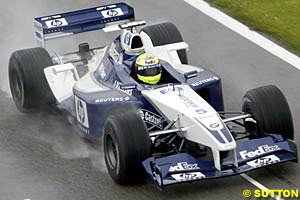 A completely new sidepod and engine cover set-up was introduced. At first the set up appeared to be a simple addition of Ferrari-like winglets on top of the sidepods, but closer examination proved the coke bottle shape of the sidepods has been dramatically narrowed. The sidepods start with the usual shape, then as the long lower flip up starts, the bodywork is narrowed and chamfered to the point where only the exhaust pipe covers form the flat top of the sidepod, and the flip up is now much wider to meet the narrower bodywork.
A completely new sidepod and engine cover set-up was introduced. At first the set up appeared to be a simple addition of Ferrari-like winglets on top of the sidepods, but closer examination proved the coke bottle shape of the sidepods has been dramatically narrowed. The sidepods start with the usual shape, then as the long lower flip up starts, the bodywork is narrowed and chamfered to the point where only the exhaust pipe covers form the flat top of the sidepod, and the flip up is now much wider to meet the narrower bodywork.
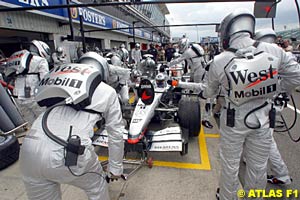 Friday and Saturday went largely trouble free for the team, as they learnt about the Michelin tyres on the wet track. Soon comments started to come from the drivers about a lack of grip and understeer, and sure enough these issues were to badly affect their race.
Friday and Saturday went largely trouble free for the team, as they learnt about the Michelin tyres on the wet track. Soon comments started to come from the drivers about a lack of grip and understeer, and sure enough these issues were to badly affect their race.
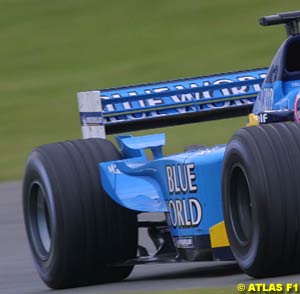 Jarno Trulli worked the first two days of the weekend curing a front end set up problem. Jenson Button was happier with the car but suffered an engine failure in qualifying. This meant the Briton had to use the T-Car, which did not havce the new aero package. As a result, he struggled to set as faster time as his teammate.
Jarno Trulli worked the first two days of the weekend curing a front end set up problem. Jenson Button was happier with the car but suffered an engine failure in qualifying. This meant the Briton had to use the T-Car, which did not havce the new aero package. As a result, he struggled to set as faster time as his teammate.
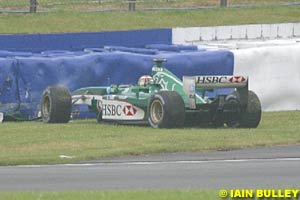 In addition to the new front wing and barge boards (see the British GP Preview), Jaguar also had some revisions to the floor and engine covers. But the set up had yet to be run at Silverstone previous to this weekend, and with Jaguar having waited for so long to run the bodywork, the wet weather restricted the data they could gain from running it on Friday.
In addition to the new front wing and barge boards (see the British GP Preview), Jaguar also had some revisions to the floor and engine covers. But the set up had yet to be run at Silverstone previous to this weekend, and with Jaguar having waited for so long to run the bodywork, the wet weather restricted the data they could gain from running it on Friday.
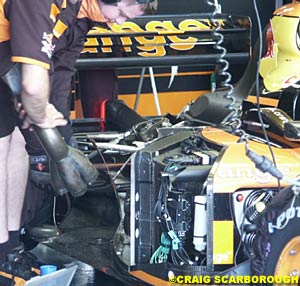 Come Saturday the team were able to rejoin the action, and fortunately Arrows have tested almost solely at Silverstone, so their set up was already well established. There were still some technical problems to hamper the team's progress, with the cars grinding to a halt exiting the pitlane and being pushed back to the main pitlane by the drivers.
Come Saturday the team were able to rejoin the action, and fortunately Arrows have tested almost solely at Silverstone, so their set up was already well established. There were still some technical problems to hamper the team's progress, with the cars grinding to a halt exiting the pitlane and being pushed back to the main pitlane by the drivers.
Please Contact Us for permission to republish this or any other material from Atlas F1.
|
Volume 8, Issue 28
Atlas F1 Exclusive
The Rise & Fall of Arrows
Q & A with Montoya
Articles
Anoraks to the Rescue
Ann Bradshaw: View from the Paddock
Tech Focus: Transporting an F1 Team
British GP Review
British GP Review
British GP - Technical Review
Champions-Elect
Stats Center
Qualifying Differentials
SuperStats
Charts Center
Columns
Season Strokes
Elsewhere in Racing
The Grapevine
> Homepage |